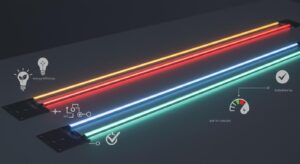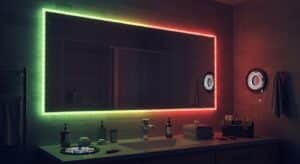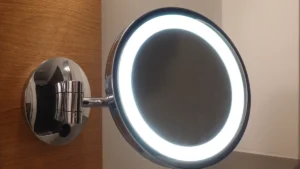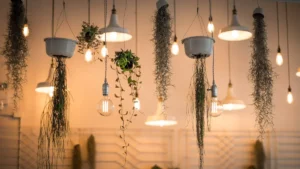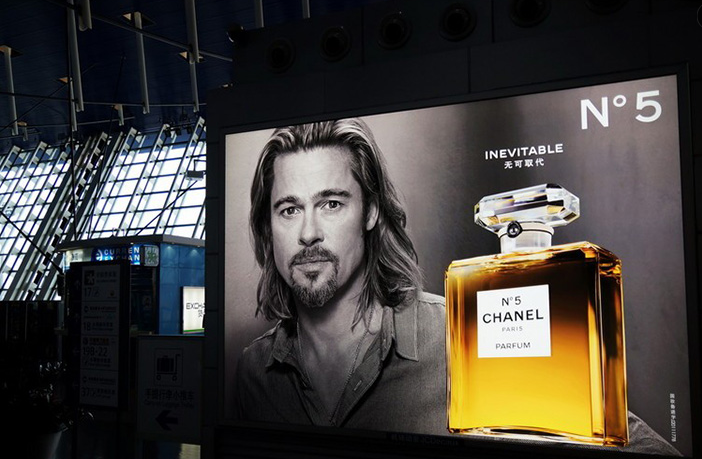
LED technology has revolutionized lighting solutions, offering versatility and efficiency. Among the popular options, backlight LED light bars and edge-lit LED panel lights stand out for their unique designs and applications. Backlight LED light bars position LEDs directly behind the panel, ensuring superior brightness and uniform illumination. This design enhances color accuracy and contrast, making it ideal for tasks requiring precision. In contrast, edge-lit LED panel lights place LEDs along the edges, directing light inward through a guide plate. This approach creates thinner, more cost-effective designs, perfect for spaces where aesthetics and budget are priorities.
Key Takeaways
Backlit LED light bars provide superior brightness and uniform illumination, making them ideal for precision tasks like photography and off-road driving.
Edge-lit LED light bars are slim and energy-efficient, perfect for modern interiors and decorative applications where aesthetics are a priority.
When choosing between the two, consider your specific needs: backlit for high performance and edge-lit for cost-effectiveness and style.
Evaluate the lumen output to ensure adequate brightness for your application; higher lumens indicate better visibility.
Durability matters: backlit designs are robust for demanding environments, while edge-lit options may be more prone to damage due to their thinner structure.
Always assess the long-term value of your investment; backlit panels may cost more upfront but can save on energy and maintenance in the long run.
Check for warranties and customer reviews to ensure you select a reliable LED light bar that meets your expectations.
What is a Backlight LED Light Bar?
A backlight LED light bar is a lighting solution where the LEDs are positioned directly behind the panel. This design ensures even light distribution across the surface, making it a preferred choice for applications requiring consistent brightness and color accuracy. Back-lit technology has gained popularity due to its ability to deliver superior illumination in various settings, from professional environments to personal projects.
How Backlit LED Light Bars Work
Backlit LED light bars operate by placing LED bulbs directly behind the panel. This arrangement allows the light to pass through a diffuser, ensuring uniform brightness across the entire surface. Unlike edge-lit designs, which rely on light guides, back-lit panels eliminate the risk of uneven lighting or hotspots. The direct placement of LEDs enhances the overall brightness and provides better control over color rendering. This makes back-lit panels ideal for tasks that demand precision, such as photography, graphic design, or medical imaging.
Key Features of Backlit LED Light Bars
Backlit LED light bars come with several standout features that set them apart:
Uniform Illumination: The direct placement of LEDs ensures consistent brightness without dark spots or uneven areas.
Enhanced Color Accuracy: Back-lit panels deliver superior color rendering, making them suitable for applications requiring precise visuals.
Durability: These light bars often feature a solid and rigid structure, ensuring longevity even in high-traffic or demanding environments.
Brightness Control: Many back-lit LED light bars offer adjustable brightness levels, allowing you to customize the lighting based on your needs.
Versatility: Available in various sizes, from compact 10-inch models to larger 50-inch options, they cater to diverse requirements.
For example, some back-lit LED light bars, like those offered by Baja Designs, boast advanced optics and impressive lumen counts. Their products, such as the OnX6+ series, provide exceptional brightness and come with a reliable lifetime warranty, ensuring long-term performance.
Common Applications of Backlit LED Light Bars
Backlit LED light bars are versatile and find use in a wide range of applications:
Off-Road Adventures: These light bars are perfect for vehicles navigating unlit terrains. They provide extra brightness, helping you spot obstacles and changes in the path ahead.
Professional Settings: Industries like photography, videography, and medical imaging rely on back-lit panels for their superior color accuracy and uniform illumination.
Automotive Enhancements: Car and truck enthusiasts often use back-lit LED light bars to enhance visibility and add a stylish touch to their vehicles.
Commercial Spaces: Retail stores and offices use back-lit LED panel lights to create well-lit environments that improve productivity and customer experience.
Home Projects: DIY enthusiasts appreciate the durability and brightness of back-lit panels for tasks like crafting or setting up home studios.
Whether you’re exploring unfamiliar trails at night or working on a detailed project, a back-lit LED light bar can provide the reliable illumination you need. Its combination of brightness, durability, and versatility makes it a valuable addition to any lighting setup.
What is an Edge-Lit LED Light Bar?
An edge-lit LED light bar is a modern lighting solution where LEDs are positioned along the edges of a panel. This design directs light inward through a light guide plate, which disperses the illumination evenly across the surface. The slim and lightweight structure of edge-lit panels makes them a popular choice for applications where space-saving and aesthetics are essential. These light bars are widely used in devices like laptops, tablets, and smartphones due to their sleek profiles.
How Edge-Lit LED Light Bars Work
Edge-lit LED light bars function by placing LED modules along the edges of the panel. The light emitted from these LEDs travels sideways into a light guide plate, which then distributes the light uniformly across the surface. This innovative design eliminates the need for LEDs to be placed directly behind the panel, resulting in a thinner and more compact structure. The light guide plate plays a crucial role in ensuring even illumination, making edge-lit panels suitable for both functional and decorative purposes.
For example, edge-lit LED panels often feature sturdy anodized extruded aluminum frames that protect the LED strips and act as heat sinks. This enhances the durability and lifespan of the lighting system. Additionally, the design allows for creative applications, such as custom-engraved acrylic panels or illuminated signs, which can add a modern touch to any space.
Key Features of Edge-Lit LED Light Bars
Edge-lit LED light bars offer several distinct features that make them stand out:
Slim Design: The placement of LEDs along the edges reduces the overall thickness, making these light bars ideal for compact spaces.
Uniform Illumination: The light guide plate ensures even light distribution, eliminating dark spots or uneven brightness.
Energy Efficiency: Edge-lit designs consume less power while delivering sufficient brightness, contributing to lower energy costs.
Customizable Applications: These light bars can be used for creative projects, such as illuminated signs, logos, or decorative panels.
Durability: The aluminum housing protects the LEDs and extends their lifespan by acting as a heat sink.
For instance, edge-lit panel lights are often used in residential and commercial settings to create a sleek and modern look. Their ability to provide consistent illumination while maintaining a thin profile makes them a versatile choice for various lighting needs.
Common Applications of Edge-Lit LED Light Bars
Edge-lit LED light bars are highly versatile and find applications in numerous settings:
Interior Design: Use edge-lit panels to create a modern ambiance in homes, offices, or retail spaces. Their slim design complements contemporary aesthetics.
Advertising and Signage: Businesses often use LED edge-lit panels for illuminated signs, logos, or acrylic displays. These panels draw attention with their vibrant and uniform lighting.
Consumer Electronics: Devices like laptops, tablets, and smartphones rely on edge-lit technology for their thin and lightweight designs.
Decorative Lighting: Edge-lit LED light bars are perfect for creating custom lighting solutions, such as engraved acrylic panels or edge-lit glass fixtures.
Energy-Efficient Spaces: Their low power consumption makes them an excellent choice for eco-friendly lighting setups.
Whether you want to enhance your interior design, advertise your business, or create a unique decorative piece, edge-lit LED light bars provide a reliable and stylish solution. Their combination of functionality, energy efficiency, and aesthetic appeal makes them a valuable addition to any lighting project.
Side-by-Side Comparison of Backlit and Edge-Lit LED Light Bars
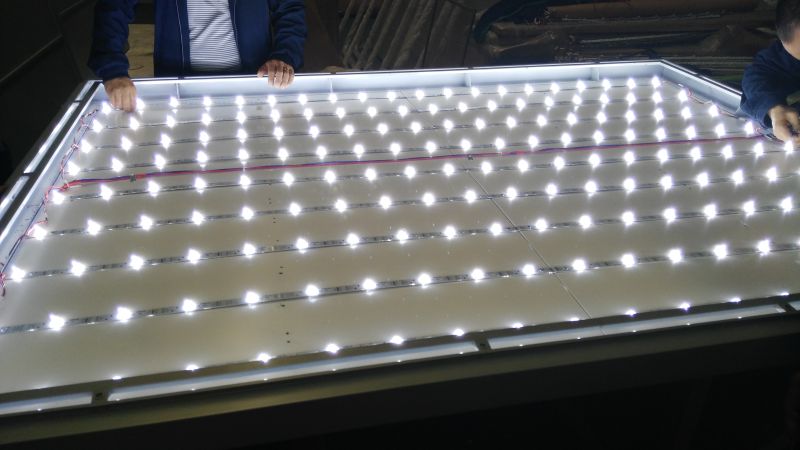
Brightness
When it comes to brightness, the back-lit panel stands out for its superior illumination. The placement of LEDs directly behind the panel ensures a higher light output, measured in lumens, which translates to a brighter and more intense glow. This makes the backlight LED light bar an excellent choice for tasks requiring high visibility, such as off-road driving or professional environments like photography studios. The backlit panel light also eliminates dark spots, ensuring consistent brightness across the entire surface.
In contrast, the led edge-lit panel provides sufficient brightness for most applications but may not match the intensity of a back-lit panel. The light emitted from the edges travels through a guide plate, which can slightly reduce the overall brightness. However, this design is ideal for spaces where softer lighting is preferred, such as residential interiors or decorative setups. For example, edge-lit panels are commonly used in modern homes to create a warm and inviting ambiance.
Pro Tip: When evaluating brightness, focus on the effective lumen value rather than just the advertised lumens. This gives you a clearer picture of the actual light output.
Uniformity of Light Distribution
The back-lit panel excels in delivering uniform light distribution. The direct placement of LEDs behind the panel ensures that the light spreads evenly, eliminating any risk of uneven illumination or hotspots. This feature is particularly beneficial for applications requiring precision, such as medical imaging or graphic design. The led back-lit panel provides a consistent and reliable lighting experience, making it a preferred choice for professionals.
On the other hand, the led edge-lit panel relies on a light guide plate to disperse light evenly across the surface. While this design achieves a good level of uniformity, it may occasionally result in slight variations in brightness, especially at the edges. Despite this, the edge-lit panel remains a popular option for decorative and aesthetic purposes, where perfect uniformity is not a critical requirement.
Did You Know? The beam pattern of an LED light bar, such as spot or flood combos, can also influence the uniformity of light distribution. Choose the right pattern based on your specific needs.
Energy Efficiency
Energy efficiency is a key consideration when choosing between these two types of led panel lights. The back-lit panel consumes more power due to the higher number of LEDs required for its design. While this results in better brightness and uniformity, it may lead to slightly higher energy costs. However, advancements in LED technology have made modern back-lit panels more energy-efficient than ever before.
The led edge-lit panel, with its minimalist design, uses fewer LEDs and consumes less power. This makes it a cost-effective and eco-friendly option for those looking to reduce energy consumption. The energy efficiency of edge-lit panels makes them ideal for long-term use in residential and commercial spaces, where lower electricity bills are a priority.
Quick Tip: If energy efficiency is your top concern, consider the wattage and lumens-per-watt ratio of the LED light bar. Higher ratios indicate better efficiency.
Cost
When comparing the cost of lighting solutions, the design and functionality of the product play a significant role. A back-lit panel generally costs more than an edge-lit panel due to its construction. The placement of LEDs directly behind the panel in a back-lit design requires more components, such as additional LED chips and diffusers. This results in higher production costs, which are reflected in the price. However, the superior brightness and uniformity of a back-lit panel justify the investment for applications requiring precision and high-quality illumination.
In contrast, an edge-lit panel offers a more budget-friendly option. The design, which positions LEDs along the edges, uses fewer materials and simplifies the manufacturing process. This makes the led edge-lit panel a cost-effective choice for those prioritizing affordability without compromising on functionality. For example, edge-lit panels are ideal for residential spaces or decorative projects where thinner designs and moderate brightness levels suffice.
Tip: While evaluating costs, consider the long-term value. A back-lit panel may have a higher upfront cost but could save money over time due to its durability and performance in demanding environments.
Applications and Use Cases
The applications of back-lit and edge-lit panels vary based on their unique features. A back-lit panel excels in scenarios requiring intense brightness and precise light distribution. You might find it indispensable for professional settings like photography studios, medical imaging, or automotive enhancements. Its ability to eliminate dark spots and provide consistent illumination makes it a reliable choice for tasks demanding accuracy.
On the other hand, an edge-lit panel shines in areas where aesthetics and space-saving designs are priorities. You can use a led edge-lit panel to create sleek and modern interiors in homes, offices, or retail spaces. Its slim profile and energy efficiency make it perfect for decorative lighting, illuminated signage, or consumer electronics like laptops and tablets. The versatility of an edge-lit panel allows you to explore creative applications, such as custom-engraved acrylic displays or edge-lit glass fixtures.
Pro Tip: Match the application to the panel type. Choose a back-lit panel for high-performance needs and an edge-lit panel for stylish, space-conscious designs.
Pros and Cons of Backlit and Edge-Lit LED Light Bars

Advantages of Backlit LED Light Bars
Backlit LED light bars offer several benefits that make them a preferred choice for various applications.
Superior Brightness: The placement of LEDs directly behind the panel ensures high-intensity illumination. This design delivers consistent brightness across the surface, making it ideal for tasks requiring precision.
Uniform Light Distribution: Back-lit panels eliminate uneven lighting or hotspots. This feature is especially useful in professional environments like photography studios or medical imaging facilities.
Enhanced Color Accuracy: The direct LED arrangement improves color rendering, providing vibrant and true-to-life visuals. This makes backlit LED light bars suitable for industries where accurate color representation is critical.
Durability: These light bars often feature robust construction, ensuring long-lasting performance even in demanding conditions. Their solid structure withstands wear and tear, making them reliable for heavy-duty use.
Versatility: Backlit LED light bars come in various sizes and configurations, catering to diverse needs. Whether for off-road adventures or commercial lighting, they adapt to multiple scenarios.
Example: A backlight LED light bar, such as those used in automotive lighting, provides exceptional visibility during nighttime driving, ensuring safety and reliability.
Disadvantages of Backlit LED Light Bars
Despite their advantages, backlit LED light bars have some limitations that you should consider.
Thicker Design: The placement of LEDs behind the panel increases the overall thickness. This may not suit applications where a slim profile is essential.
Higher Energy Consumption: Back-lit panels require more LEDs to achieve their brightness and uniformity. This results in slightly higher energy usage compared to edge-lit designs.
Cost: The advanced construction and additional components make backlit LED light bars more expensive. While the investment pays off in performance, it may not fit every budget.
Heat Generation: The dense LED arrangement can lead to increased heat output. Although modern designs include heat sinks, this factor may still affect efficiency in some cases.
Tip: If you prioritize brightness and durability over cost and size, a backlit LED light bar is an excellent choice.
Advantages of Edge-Lit LED Light Bars
Edge-lit LED light bars bring unique benefits that cater to specific needs and preferences.
Slim and Lightweight Design: The placement of LEDs along the edges creates a thinner and more compact structure. This makes edge-lit panels perfect for applications where space-saving is crucial.
Energy Efficiency: Edge-lit designs use fewer LEDs, consuming less power while maintaining sufficient brightness. This reduces energy costs and supports eco-friendly practices.
Cost-Effective: The simplified construction of edge-lit panels lowers production costs. This makes them an affordable option for residential and commercial lighting projects.
Aesthetic Appeal: The sleek design of edge-lit LED light bars enhances modern interiors. They blend seamlessly into contemporary spaces, adding a touch of elegance.
Creative Applications: Edge-lit panels work well for decorative purposes, such as illuminated signs or custom-engraved displays. Their versatility allows for innovative lighting solutions.
Example: Edge-lit LED panel lights are commonly used in retail stores to create an inviting ambiance while maintaining energy efficiency.
Disadvantages of Edge-Lit LED Light Bars
Edge-lit LED light bars, while sleek and efficient, come with certain drawbacks that you should consider before making a decision. These limitations may impact their suitability for specific applications.
Reduced Brightness: The placement of LEDs along the edges often results in lower overall brightness compared to backlit designs. This can make edge-lit panels less effective for tasks requiring intense illumination, such as off-road driving or professional-grade lighting setups.
Potential for Uneven Lighting: Although the light guide plate helps distribute light across the surface, slight variations in brightness may still occur. You might notice dimmer areas near the center or edges, especially in larger panels. This can affect the visual quality in applications where uniformity is critical.
Limited Color Accuracy: Edge-lit designs may struggle to achieve the same level of color accuracy as backlit panels. The indirect light path can lead to subtle distortions in color rendering, which could be a concern for industries like photography or graphic design.
Durability Concerns: The thinner and more compact structure of edge-lit panels, while advantageous for aesthetics, may compromise durability. These light bars are more prone to damage under heavy use or in demanding environments, such as outdoor adventures or industrial settings.
Restricted Customization: Edge-lit LED light bars often lack advanced features like adjustable brightness or beam patterns. This limits their flexibility for users who need tailored lighting solutions for specific scenarios.
Note: While edge-lit LED light bars excel in energy efficiency and modern design, their limitations make them less suitable for high-performance or precision-focused applications. Always weigh these factors against your specific needs to ensure the best choice.
How to Choose the Right LED Light Bar for Your Needs
Selecting the right LED light bar requires careful consideration of your specific needs and preferences. Whether you prioritize performance, energy efficiency, or aesthetics, understanding the key factors will help you make an informed decision.
Factors to Consider (e.g., brightness, energy efficiency, cost)
Brightness: Evaluate the lumen output of the LED light bar. Higher lumens indicate greater brightness, which is essential for tasks requiring intense illumination. For example, a back-lit LED panel light offers superior brightness, making it ideal for off-road driving or professional environments. If you need moderate lighting for decorative purposes, an edge-lit LED panel light may suffice.
Energy Efficiency: Consider the power consumption of the light bar. Edge-lit designs typically consume less energy due to their minimalist structure, making them a cost-effective choice for long-term use. Back-lit options, while slightly more power-intensive, provide unmatched brightness and uniformity, which can justify the additional energy usage in demanding applications.
Cost: Assess your budget and weigh it against the features you need. Back-lit LED light bars often come with a higher price tag due to their advanced construction and superior performance. On the other hand, edge-lit LED panel lights offer a more affordable solution without compromising on basic functionality. Always consider the long-term value, including durability and energy savings.
Durability: Look for robust construction materials like aluminum housing, which enhances the lifespan of the light bar. For instance, products like the LiT E-Series 10″ LED light bar feature rugged aluminum bodies and high-powered LEDs with a lifespan of 50,000 hours, ensuring reliability in tough conditions.
прикладн: Match the light bar to its intended use. For vehicles, choose a model with high lumen output and durable construction. For home or commercial spaces, prioritize slim designs and energy efficiency.
Pro Tip: Always check the warranty and customer reviews. A reliable warranty, like the lifetime coverage offered by some brands, ensures peace of mind and long-term satisfaction.
Choosing between a backlight led light bar and an edge-lit option depends on your specific needs. Backlight led light bars excel in delivering superior brightness and uniformity, making them ideal for tasks requiring precision or high visibility. On the other hand, edge-lit designs offer a sleek, thinner profile and cost-effective solutions, perfect for modern interiors or decorative applications. Evaluate factors like application, budget, and design preferences to make the right choice. Whether you prioritize performance or aesthetics, understanding these differences ensures you select the most suitable led lighting solution for your project.
FAQ
What is the main difference between backlit and edge-lit LED light bars?
The primary difference lies in the placement of the LEDs. Backlit LED light bars position LEDs directly behind the panel, ensuring uniform brightness and superior color accuracy. Edge-lit LED light bars place LEDs along the edges, directing light inward through a guide plate, resulting in a thinner design and energy efficiency.
Expert Insight: According to Extreme Tactical Dynamics, understanding the functions you need from your light bar is essential. Backlit designs excel in brightness, while edge-lit options prioritize sleekness and cost-effectiveness.
Are edge-lit LED light bars suitable for professional environments?
Edge-lit LED light bars work well in professional environments where aesthetics and energy efficiency are priorities. They are commonly used in offices, retail spaces, and interior design projects due to their slim profile and modern look.
Did You Know? Edge-lit panels are often used in illuminated signage and decorative lighting, adding a refined touch to commercial spaces.
How do I choose the right size for my LED light bar?
Consider the application and available space. For vehicles, measure the mounting area to ensure a proper fit. For home or commercial use, select a size that complements the design and provides adequate illumination.
Example: Sunlite recommends choosing a size that aligns with your specific needs, whether it’s a compact 10-inch bar for tight spaces or a larger 50-inch bar for broader coverage.
What factors should I consider before buying an LED light bar?
Focus on brightness (lumens), energy efficiency, durability, and cost. Assess the intended use, such as off-road driving, interior design, or decorative purposes. Match the light bar’s features to your specific requirements.
Expert Advice: The Drive emphasizes the importance of evaluating lumens and individual lights for optimal brightness and coverage.
Are backlit LED light bars more expensive than edge-lit ones?
Yes, backlit LED light bars are generally more expensive. Their design requires more components, such as additional LEDs and diffusers, which increase production costs. However, their superior brightness and uniformity justify the higher price for demanding applications.
Quick Tip: While edge-lit options are more budget-friendly, backlit designs offer better performance for tasks requiring precision.
Can I install an LED light bar myself?
Yes, most LED light bars come with straightforward installation instructions. However, professional installation ensures optimal performance and avoids potential issues. For vehicle-mounted light bars, secure brackets and proper wiring are crucial.
Pro Insight: Specialty Performance Parts highlights the importance of proper installation for achieving the best results from your LED light bar.
Are LED light bars energy-efficient?
Both backlit and edge-lit LED light bars are energy-efficient compared to traditional lighting. Edge-lit designs consume less power due to fewer LEDs, making them ideal for long-term use in residential and commercial spaces.
Fun Fact: According to HitLights, LED light bars not only save energy but also offer durability, making them suitable for high-traffic areas.
Which brands offer high-quality LED light bars?
Brands like BLUEVIEW and SUNLITE LED are known for their high-quality LED light bars. They provide reliable performance, advanced features, and durable construction, catering to various needs.
Recommendation: Look for products with warranties and positive customer reviews to ensure long-term satisfaction.
How do I maintain my LED light bar?
Regularly clean the surface to remove dust and debris. Check the wiring and mounting brackets for any signs of wear or damage. For outdoor use, ensure the light bar is weatherproof and protected from extreme conditions.
Pro Tip: Choose LED light bars with aluminum housing, as it acts as a heat sink and enhances durability.
See Also
Comparing Edge-Lit And Backlit LED Lights For Displays
Understanding Backlight LED Bars And Their Functionality
Best LED Strip Lights In 2024: Features And Prices
